I never read the Archie Comics as a kid. They weren’t popular here in the UK, so my introduction to the ‘Archieverse’ was in 2017, when the first season of Riverdale began airing. Like many others, I went into it expecting a run-of-the-mill teen drama, akin to Pretty Little Liars or One Tree Hill. But, having stuck by the show throughout its entire runtime, I had a front row seat to watch in real-time how the show managed to transform into something completely different. The way I see it, Riverdale used the Trojan Horse of the teen drama premise to sneak something incredibly unique onto network television that goes far beyond what you may get out of a casual, surface level viewing of the show. In a way, Riverdale is the epitome of pop culture, mashed together in a way that reflects back onto the audience. And in an age of a multitude of comics-to-screen adaptations, I find that Riverdale is one of the few asking the audience the same question many writers rooms would have on day one. What really happens when you bring classic comic book characters to life in the modern day?
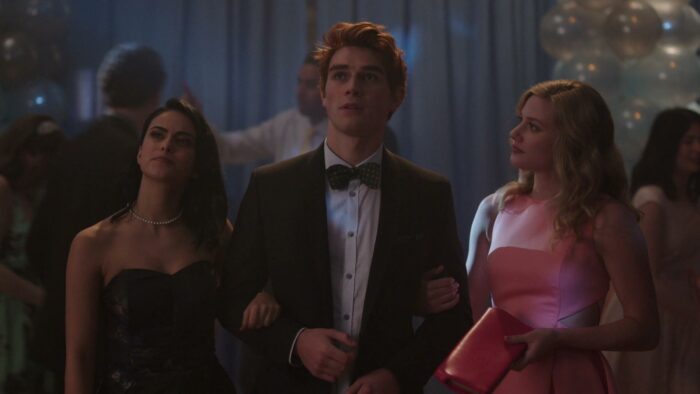
In the pilot episode, we’re introduced to our core four—Archie Andrews (KJ Apa), Jughead Jones (Cole Sprouse), Veronica Lodge (Camila Mendes), and Betty Cooper (Lili Reinhart)—who audiences first met in the 1940s as characters in Pep Comics (now called Archie Comics). The show wastes no time igniting the famous love triangle between Betty, Veronica, and Archie, paying direct homage to the original source material. But it’s clear that there are, as our narrator Jughead says in the opening monologue, “shadows underneath” the town of Riverdale, marking this as a darker, edgier adaptation. Riverdale’s first season concerns itself with trying to establish this difference, centering around the murder of Cheryl Blossom’s (Madelaine Petsch) twin brother, taking major inspiration from Twin Peaks, both cinematically and within the plot.
It’s one of the first and most glaring homages you see coming out of the show’s seemingly unlimited arsenal of pop culture, with references woven into its very fabric. This new style for the ‘Archieverse’ allows perfectly for the blending of the original 1950s comic aesthetic and the modern, or iconic, connections that appear throughout. However, the first season of the show, to me personally, is the worst, as it doesn’t yet fully commit to what makes the show great in the later seasons. It plays it too straight, solving the murder mystery and wrapping everything up neatly by the season finale. As the show continues, it gains more confidence in itself to not have to fit into the teen drama mould, and becomes its own entity within the TV landscape where nothing is too absurd to explore.
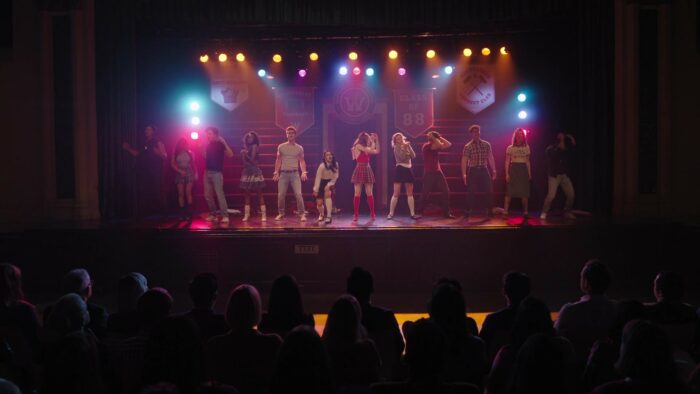
Season 3 is where the most of the general audience tuned out of the show. No time was wasted in introducing the cult “The Farm” and the deadly board game Gryphons and Gargoyles, embracing supernatural elements and ridiculous plots that went far beyond the simple murder mysteries of the earlier seasons. This turning point in Riverdale, while it caused many to write it off as spiraling out of control, was exactly what pulled me into the show. It was the first time I saw the full charm of the writing, and how they played absurd situations like town wide seizures with tongue-in-cheek seriousness. From my point of view, this writing style clearly intentionally came with merging the tone of the ’50s Archie Comics with the modern-day TV landscape, giving way to brilliant lines like “Follow me, your Gryphon Queen, away from this fortress and back to the kingdom of Eldervair!” when saving a group of girls from an orphanage, having to play along with their belief that they were living in the realm of the aforementioned boardgame, Eldervair, which is of course an anagram for Riverdale.
The plotline of the game explores how it had been targeted at impressionable teens in the orphanage as a coping mechanism, taking inspiration from the satanic panic that spawned from the real game Dungeons and Dragons. The episode where we get the backstory of the game is entitled “The Midnight Club,” after the 1984 film The Breakfast Club, and is a flashback episode to the ’90s when the teen characters’ parents were in detention in high school and formed a friendship through playing it together. This, to me, is why Riverdale works. It’s a love letter to pop culture, pulling references from all over the place and melding them together into satirical storylines that make you feel as if you are in on the joke; yet somehow it works as it is grounded in the cheesy earnestness of the characters.
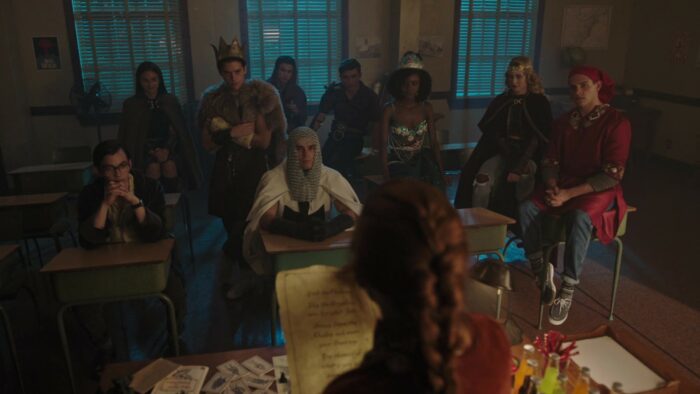
While the first half of the show focuses its attention to wider pop culture, the latter half concerns itself with more familiar territory—the Archie Comics, building upon the world created by drawing in comic book elements that take us back to why many started watching the show in the first place.
After a seven-year time jump, we see Archie and his friends return to Riverdale as adults, in an attempt to save the town. After losing direction in the middle of the show, the return to the original comics acted as a guide until the series finale, allowing Riverdale to go bigger and wackier than they had ever gone before.
Season 6 opened up with a five-episode-long supernatural event, in the parallel universe called Rivervale. It represented a darker version of the town, where everything was just so slightly wrong, but not too dissimilar that we didn’t recognise it. This is where Riverdale started to explore the notion of good and evil, and used its main cast of characters as a beacon of morality in a morally corrupt town. The parallel universe highlighted and accentuated the premise that was set up in the first season of the show, that the original quaint and unassuming 1950s-style town of Riverdale from the comics had somehow become corrupted in this adaptation, and this was something the characters had to work together to fix.
Paying homage to comics like Blossoms 666 and Jughead’s Time Police, the event gave us insight into a bleak, eerie version of Riverdale, including introducing the devil in the character Mr. Cypher, and then showed us how this version was beginning to seep into the real town. When the supernatural event ended and we returned to Riverdale, the character of Abigail Blossom—Cheryl’s ancestor from the 1980s who was a witch—returned with us, and the supernatural happenings that bled into the town as a result led to the ultimate battle of good and evil.
Taking after the comics Archie’s Superteens, the characters gained superpowers, like Archie’s invincibility, Cheryl’s pyrokinesis, and Jughead’s mind reading ability, in order to take down the immortal Percival Pickens (Chris O’Shea), who wanted to take over the town. In the end, surprisingly, it’s a battle the main characters lose, as a comet hits the town of Riverdale and destroys it forever. It’s certainly not the outcome many expected, and the season ends with Tabitha using her powers of time manipulation to send everyone back to the 1950s just before the comet hits, saving them, but not Riverdale.
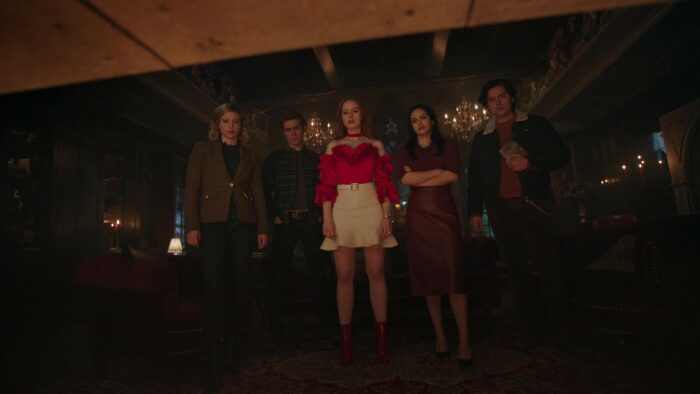
An important part of Riverdale I’ve yet to pay much attention to is Pop’s Chock’lit Shoppe, the diner where the characters spend a large majority of their time. The diner is owned by Pop, who is written to be a symbol of goodness and kindness, and who offers a home for the characters when they feel there is no other place to go. Pop’s diner is somewhere the characters always seem to be fighting for, like at the beginning of Season 2 where Veronica rallies to save Pop’s from being bought by people who wanted to tear it down, eventually going on to own and run the diner in Seasons 3 and 4.
In the later time-jump, we are introduced to Tabitha Tate (Erinn Westbrook), Pop’s granddaughter, who takes over the diner when he can no longer do it on his own. We see her try to expand Pop’s and franchise it, bringing new ideas and ways to make it a special place where the people of Riverdale can go.
The diner is an anchor the story of Riverdale surrounds itself around, from right at the beginning, when we see Jughead typing his first narration in a booth at Pop’s in the pilot, to the final scene of the show. The characters feel a sense of safety and familiarity there, and beyond any of their houses, it represents their home. It’s the heart of the town, and is ultimately the place where the town-destroying comet hits, signaling the end of the town and its most sacred place. The diner also constantly reminds audiences of the story’s origins in the 1940s and 1950s, creating a space of timelessness that encompasses the show’s feeling of not being restricted to one moment in time or era, allowing the plots to take big swings as there is a center of gravity they all revolve around that isn’t tied down. Something as simple as a diner set therefore adds to the world of Riverdale in the sense that it makes it feel real, as if there is something in the town worth caring about and that there is heart in all the craziness surrounding it.
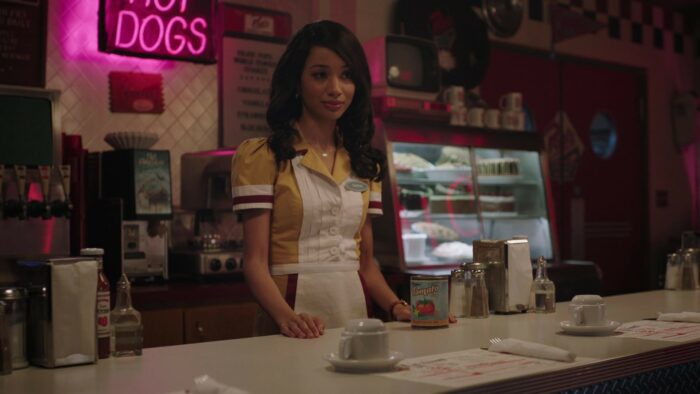
Season 7 is when all the pieces of the show get put together, and you start to understand what all of this was about. The season wipes the characters’ memories, makes them teenagers in high school again, and has them exist in what we can presume is the original Riverdale from the comics. However, the characters still hold their fabrics, and many of them face struggles in the ’50s that were echoes of what they went through in the modern day. Cheryl battles the homophobia of her parents, Toni stands up against racism, Jughead fights censorship in literature and comics, and Betty tackles sexism against women—again having the characters be morally just in a world that is not.
It becomes clear that all along this stemmed from the comics, where Archie represented the ‘good all-American boy’ trope, and he and his friends upheld proper values. In this way the show was able to return to its origins and show a realer side of the time period, while still keeping its characters the same. The show ends with the characters regaining their memories and staying in the ’50s, as an angel version of Jughead tells us how everyone spent their lives after high school, all moving away from Riverdale and finding happiness and success. It’s a satisfying ending, but on the surface feels as if it lacks a big emotional conclusion to the characters and their stories.
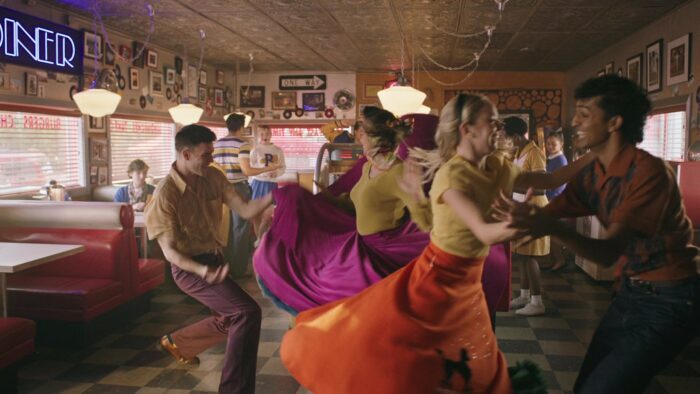
Initially, like many others, I was slightly disappointed with this ending, where it seems as if the town of Riverdale that we had rooted for and followed for six years had been left behind by those who had fought for it throughout the entire run-time of the show, as it didn’t seem to follow much of what we had seen before. But the final scene of the show ties it together, and finally allowed me to understand what Riverdale had been saying all along.
The final scene shows Betty arriving at Pop’s Diner in the afterlife, greeting her friends who are all waiting for her. They’re in their ’50s attire, making it clear that this is the timeline where they stayed for the rest of their lives. Outside the diner, angel Jughead watches and narrates his final lines:
“We’ll leave them here, I think. Where they’re forever juniors, forever 17… That’s where they’ve, or we’ve, always been. In this diner, in this town, in the Sweet Hereafter. So if you happen to see that neon sign some lonely night, at the end of a long journey, the journey that every one of us is on, pull over, come on in, take a seat, and know that you’ll always be among friends, and that Riverdale will always be your home.”
The emotion in these lines seemed to sum up the show perfectly, and also explained to me what the point of it was overall. The characters in the Archie Comics have existed back as far as the 1940s, some being introduced right at the beginning and some coming along later, but ultimately their place is in the ’50s, the era the comics really took off. The Sweet Hereafter in Pop’s felt like the characters were returning home, after being used to tell a story for the past seven seasons. It was a reminder that this was all Riverdale was, an instalment in a long history of stories involving these characters, before they return to the diner in the ’50s, back where they started. These characters exist outside of the show, and will continue to exist for a long time after the final episode. Maybe it even suggests that they were never supposed to stay too long in this new version of Riverdale, and that’s why it fell apart at the end of the sixth season, because the characters outstayed their visit.
But they’ll always be there for you to visit, to read some comic with or watch a show of, because these characters are supposed to feel like old friends that you go on adventure after adventure with, never quite knowing what the next journey will be with them. That’s why exploring multiple universes like Rivervale or the 1950s in the show worked so well, because many of us are already familiar with who these characters are at their cores before ever watching a single episode, and have already seen them in a variety of stories and situations before, where they still always felt like the characters we know and love. Ending in Pop’s diner, we feel the characters are safe and happy until we will see them again, in some other iteration, be it a comic, show, movie, or something else, we can rest assured that they are right where they’re supposed to be—in the beating heart of the town of Riverdale hanging out with their friends.
So, all that said, Riverdale is ultimately a mirror of pop culture and absurdity, and also a love letter to its original source material. It should be watched less like one would watch Dawson’s Creek, and more like how you would read a comic like Superman, with the expectation that anything could happen, and in the end it’s unimportant because the characters feel like your best friends, and you really only care about what your best friends are getting themselves into every episode. Riverdale stands alone in the TV landscape as something completely unique, while feeling strangely familiar at the same time thanks to its countless inspirations. I’d encourage anyone to give it a try, throw it on and embrace the crazy storylines just as much as the characters themselves do. If you find yourself laughing at the insanity, congratulations, you’re finally in on the joke.


What an incredible sun up of such an iconic series! So well written